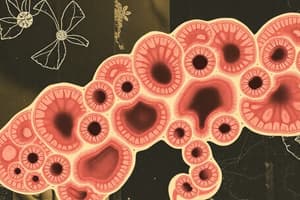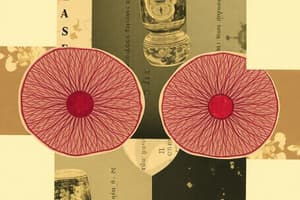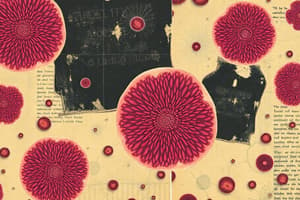Podcast
Questions and Answers
What characterizes glandular epithelium?
What characterizes glandular epithelium?
- It is primarily squamous in shape.
- It has a secretory function. (correct)
- It consists only of unicellular structures.
- It lacks any connection to surface epithelium.
How are exocrine glands classified based on cell number?
How are exocrine glands classified based on cell number?
- They can only be multicellular structures.
- They are only formed from epithelial cells.
- They are exclusively multicellular structures of large cells.
- They include both unicellular and multicellular structures. (correct)
What distinguishes endocrine glands from exocrine glands?
What distinguishes endocrine glands from exocrine glands?
- Endocrine glands are ductless. (correct)
- Endocrine glands can only secrete proteins.
- Endocrine glands do not participate in secretion.
- Endocrine glands have ducts for secretion.
Which type of gland retains its connection with the surface epithelium through a duct?
Which type of gland retains its connection with the surface epithelium through a duct?
What is the main function of glandular epithelium?
What is the main function of glandular epithelium?
What describes a simple tubular gland?
What describes a simple tubular gland?
Which of the following best describes a compound gland?
Which of the following best describes a compound gland?
Which type of gland is characterized by having a secretory portion that is forked into several tubules?
Which type of gland is characterized by having a secretory portion that is forked into several tubules?
What distinguishes a simple alveolar gland?
What distinguishes a simple alveolar gland?
What type of gland is the sweat gland of humans classified as?
What type of gland is the sweat gland of humans classified as?
Flashcards
Glandular Epithelium
Glandular Epithelium
Epithelium specialized for secretion, typically cuboidal or columnar.
Exocrine Gland
Exocrine Gland
Gland that retains a connection to the surface via a duct to release secretions.
Endocrine Gland
Endocrine Gland
Ductless gland; releases secretions directly into the bloodstream.
Unicellular gland
Unicellular gland
Signup and view all the flashcards
Multicellular gland
Multicellular gland
Signup and view all the flashcards
Simple Tubular Gland
Simple Tubular Gland
Signup and view all the flashcards
Simple Coiled Tubular Gland
Simple Coiled Tubular Gland
Signup and view all the flashcards
Simple Branched Tubular Gland
Simple Branched Tubular Gland
Signup and view all the flashcards
Simple Alveolar Gland
Simple Alveolar Gland
Signup and view all the flashcards
Simple Branched Alveolar Gland
Simple Branched Alveolar Gland
Signup and view all the flashcards
Study Notes
Glandular Epithelia
- Glandular epithelium is specialized epithelium with secretory function.
- It's typically cuboidal or columnar.
- It forms the secretory portion of glands, producing and secreting the glandular product.
- Glands can be single secretory cells (e.g., goblet cells) or groups of cells forming larger glands.
- Secretory cells synthesize, store, and release proteins, lipids, or carbohydrate-protein complexes.
Formation of Glandular Epithelium
- Gland formation begins during embryonic development.
- Epithelial cells form in connective tissue beneath existing epithelium.
- Initially, glands are connected to the surface epithelium via a duct.
- Later, glands differentiate into endocrine or exocrine types based on the presence or absence of ducts.
Exocrine Glands
- Secrete products into ducts leading to the surface epithelium.
- Classified by the number of cells: unicellular (e.g., goblet cells) or multicellular.
- Classified by shape: tubular or alveolar (acinar).
- Classified by duct structure: simple (single duct) or compound (branched ducts).
- Additional classification based on secretions: serous (watery), mucous (viscous), mixed (both serous and mucous).
Types of Exocrine Glands
- Simple tubular: single, unbranched duct, secretory portion is a tube
- Simple coiled tubular: single, unbranched duct, coiled secretory portion
- Simple branched tubular: single, branched duct, secretory portion is branched tubes
- Simple acinar: single, unbranched duct, sac-like secretory portion
- Simple branched acinar: single, branched duct, branched sac-like secretory portion
- Compound tubular: branched ducts, secretory portion is a tube
- Compound acinar: branched ducts, secretory portion is sac-like
- Compound tubuloalveolar: branched ducts, combined tubular and sac-like secretory portions
Modes of Secretion (Exocrine)
- Merocrine: secretions released through exocytosis (most common)
- Apocrine: secretions released with a portion of the cell's cytoplasm (e.g., mammary glands)
- Holocrine: secretions released with the entire cell's destruction (e.g., sebaceous glands)
Endocrine Glands
- Ductless glands secreting hormones directly into the bloodstream.
- Hormones have far-reaching effects, acting on target cells throughout the body.
- Hormone secretions are absorbed by thin-walled blood capillaries.
Types of Endocrine Glands (Histological Types)
- Trabecular: cells arranged in cords (e.g., adrenal glands, liver)
- Follicular: cells form spherical structures (e.g., thyroid glands)
- Disseminated: cells scattered in other tissues (e.g., Leydig cells in testes)
Hormone Types (Endocrine)
- Proteins/peptides (e.g., insulin, growth hormone)
- Lipid derivatives (steroids)
- Amino acid derivatives (e.g., epinephrine, thyroid hormones)
Hormone Effects
- Endocrine: hormones released into blood and act over long distances
- Paracrine: hormone diffuses a short distance and affects nearby cells
- Autocrine: hormones act on the same cell that produced them
Amphicrine Glands
- Exhibit both exocrine (ductal secretion) and endocrine (hormonal secretion) functions.
- Can be homotypic (same cells for both) or heterotypic (different cells for each). (e.g., pancreas)
Studying That Suits You
Use AI to generate personalized quizzes and flashcards to suit your learning preferences.




